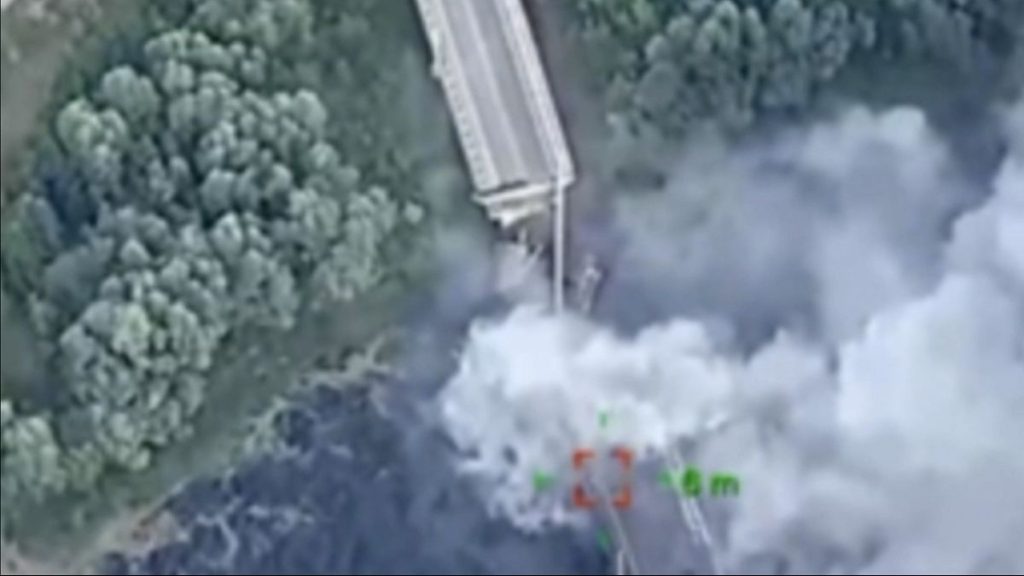The destruction of the last bridge over the Seym river in Russia’s Kursk region by Ukrainian forces threatens to hinder Moscow’s ability to supply and reinforce troops in a 700 square kilometre area of Russian territory. This bridge was the third crossing destroyed by Ukraine, following similar actions on other bridges in August. With the main bridge gone, Russian forces will now have to rely on vulnerable pontoon bridges for transportation. Analysts from the Institute for the Study of War suggest that Russia has deployed over 5,000 personnel to Kursk in response to the Ukrainian incursion into the region in early August. Ukrainian President Volodymyr Zelenskyy has stated that the incursion aims to create a buffer zone to prevent potential attacks by Moscow from across the border.
The attack on Russia marks the largest incursion into the country since World War II, with Ukrainian forces making significant advances into Russian territory with minimal resistance. Ukrainian Commander in Chief, General Oleksandr Syrskyi, claimed that his forces have moved across 1,000 square kilometres of the region. However, the extent of territory effectively controlled by Ukrainian forces could not be independently verified by Euronews. Analyst Nataliya Bugayova believes that Ukraine’s offensive in Kursk has the potential to generate momentum for the country, forcing Russia to redeploy forces and commit more resources to the area in future conflicts within Russian territory.
The destruction of the final bridge over the Seym river in Russia’s Kursk region by Ukrainian forces poses a significant challenge for Moscow, as it hampers the transport of supplies and reinforcements to Russian troops in a 700 square kilometre area. This bridge was the third crossing destroyed by Ukraine, following earlier demolitions in August. Now, Russian forces will have to rely on pontoon bridges that are vulnerable to potential attacks, further complicating their logistical situation. According to analysts at the Institute for the Study of War, Russia has redeployed more than 5,000 personnel to Kursk in response to the Ukrainian incursion that caught Moscow by surprise in early August. Ukrainian President Volodymyr Zelenskyy has indicated that the incursion aims to create a buffer zone to prevent potential attacks from Russia across the border.
The recent attack on Russia by Ukrainian forces represents the largest incursion into the country since World War II, with Ukrainian troops advancing deep into Russian territory with little resistance. General Oleksandr Syrskyi, Ukraine’s Commander in Chief, claimed that his forces have moved across 1,000 square kilometres of the region, although the actual extent of territory under Ukrainian control remains unverified. Analyst Nataliya Bugayova believes that Ukraine’s offensive in Kursk could generate momentum for the country, forcing Russia to reallocate forces and commit more resources to the region in future conflicts within Russian territory. This ongoing incursion continues to disrupt the Russian military’s operations and poses a challenge for Moscow’s strategic planning in the region.
The destruction of the last bridge over the Seym river in Russia’s Kursk region by Ukrainian forces has significantly disrupted Moscow’s ability to supply and reinforce troops in a 700 square kilometre area. This latest destruction marks the third bridge targeted by Ukrainian forces, following previous demolitions in August. With the main bridge no longer accessible, Russian forces now must rely on vulnerable pontoon bridges for transportation, leaving them more exposed to potential Ukrainian attacks. Analysts from the Institute for the Study of War suggest that Russia has deployed over 5,000 personnel to Kursk in response to the unexpected incursion by Ukrainian troops in early August. Ukrainian President Volodymyr Zelenskyy has stated that the incursion aims to create a buffer zone to deter future attacks from Russia across the border.
The recent attack on Russia by Ukrainian forces represents the largest incursion into the country since World War II, with Ukrainian troops making significant advances into Russian territory. General Oleksandr Syrskyi, Ukraine’s Commander in Chief, claims that his forces have progressed across 1,000 square kilometres of the region, although the actual extent of territory under Ukrainian control remains unverified. Analyst Nataliya Bugayova believes that Ukraine’s offensive in Kursk could create momentum for the country, compelling Russia to reallocate forces and resources to the region in future conflicts within Russian territory. This ongoing incursion presents ongoing challenges for the Russian military and affects Moscow’s strategic planning in the area, potentially leading to further escalations and clashes between Ukrainian and Russian forces.


